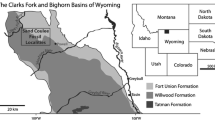Abstract
Views on the relationships of the Eocene non-adapid primates have flucutated moderately through time (Szalay 1975a). The creation of family concepts for the Omomyidae Trouessart, 1879 (including Anaptomorphidae Cope, 1883 and Microchoeridae Lydekker, 1887) signifies that these groups were previously recognized as distinct from the Adapidae Trouessart, 1879.
Access this chapter
Tax calculation will be finalised at checkout
Purchases are for personal use only
Preview
Unable to display preview. Download preview PDF.
Similar content being viewed by others
References
Bugge J (1972) The cephalic arterial system in the insectivores and the primates with special reference to the Macroscelidoidea and Tupaioidea and the insectivore-primate boundary. Z Anat Entwicklungsgesch 135: 279–300
Cartmill M (1972a) Arboreal adaptations and the origin of the order primates. In: Tuttle (ed) The functional and evolutionary biology of primates. Aldine, Chicago
Cartmill M (1972b) Strepsirhine basicranial struetures and the afflnities of the cheirogaleidae. In: Luckett WP, Szalay FS (eds) Phylogeny of the primates. Plenum Press, New York London
Cave AJE (1967) Observations on the platyrrhine nasal fossa. Am J Phys Anthropol 26: 277–288
Chivers DJ, Joysey KA (eds) (1978) Recent advanees in primatology, vol III. Evolution. Academic Press, London New York
Conroy GC (1980) Ontogeny, auditory struetures, and primate evolution. Am J Phys Anthropol 52: 443–451
Conroy GC, Packer DJ (in press) The anatomy and phylogenetic significance of the carotid arteries and nerves in strepsirhine primates. Folia Primatol
Goodman M, Hewett-Emmett D, Beard JM (1978) Molecular evidence on the phylogenetic rela- tionships of Tarsius. In: Chivers GC, Joysey KA (eds) Recent advanees in primatology, vol III. Academic Press, London New York
Hürzeler J (1948) Zur Stammesgeschichte der Necrolemuriden. Schweiz Palaeontol Abh 66: 1–46
Luckett WP (1975) Ontogeny of the fetal membranes and placenta - their bearing on primate phylogeny. In: Luekett WP, Szalay FS (eds) Phylogeny of the primates. Plenum Press, New York London
Luckett WP, Szalay FS (1978) Clades versus grades in primate phylogeny. In: Chivers DJ, Joysey KA (eds) Recent advanees in primatology, vol III. Academic Press, London New York
MacPhee RDE (1977) Ontogeny of the ectotympanie-petrosal plate relationship in strepsirhine prosimians. Folia Primatol 27: 245–283
Maier W (1979) Macrocranion tupaiodon, an adapisoricid (?) inseetivore from the Eocene of “Grube Messel” (Western Germany). Palaeontol Z 53:38–62
Pocock RI (1918) On the external characters of the lemurs and of Tarsius. Proc Zool Soc London, pp 19–53
Robinson T (1968) The paleontology and geology of the Badwater Creek area, central Wyoming, part 4. Late Eocene primates from the Badwater, Wyoming, with a discussion of the material from Utah. Ann Carnegie Mus 39 (19): 307–326
Saban R (1975) Structure of the ear region in living and subfossil lemurs. In: Tattersall I, Suss- man RW (eds) Lemur biology. Plenum Press, New York London
Simons EL (1961) Notes on Eocene Tarsioids and a revision of some Necrolemurinae. Bull Br Mus Nat ffist Geol 5 (3): 47–70
Simpson GG (1940) Studies on the earliest primates. Bull Am Mus Nat Hist 77: 185–212
Szalay FS (1972) Cranial morphology of the Early Tertiary Phenacolemur and its bearing on primate phylogeny. Am J Phys Anthropol 36: 59–76
Szalay FS (1975s) Phylogeny, adaptations, and dispersal of the Tarsiifoim primates. In: Luckett WP, Szalay FS (eds) Phylogeny of the primates. Plenum Press, New York London
Szalay FS (1975b) Phylogeny of primate higher taxa — the basicranial evidence. In: Luckett WP, Szalay FS (eds) Phylogeny of the primates. Plenum Press, New York London
Wortman JL (1903) Studies of Eocene mammalia in the Marsh Collection, Peabody Museum, paxt 2. Primates. Am J Sei 15: 163–176
Author information
Authors and Affiliations
Editor information
Editors and Affiliations
Rights and permissions
Copyright information
© 1981 Springer-Verlag Berlin Heidelberg
About this paper
Cite this paper
Schmid, P. (1981). Comparison of Eocene Nonadapids and Tarsius. In: Chiarelli, A.B., Corruccini, R.S. (eds) Primate Evolutionary Biology. Proceedings in Life Sciences. Springer, Berlin, Heidelberg. https://doi.org/10.1007/978-3-642-68251-3_2
Download citation
DOI: https://doi.org/10.1007/978-3-642-68251-3_2
Publisher Name: Springer, Berlin, Heidelberg
Print ISBN: 978-3-642-68253-7
Online ISBN: 978-3-642-68251-3
eBook Packages: Springer Book Archive




